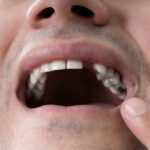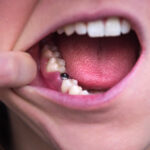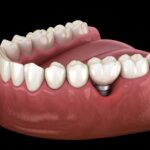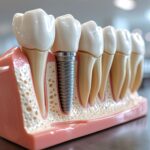A high percentage of people over the age of 30 have some form of gingivitis, and while this may sound concerning, there is good news involved – gingivitis is the early stage of gum disease, and it can be cured by practicing good oral hygiene. Visiting your dentist regularly will also help cure gingivitis because a dentist will professionally remove plaque and tartar buildup to help prevent this disease.
You have the power to build habits that can protect your oral health, and while there is no instant fix, you can achieve healthy gums.
What causes gingivitis?
Plaque leads to gingivitis. Plaque is an invisible film of bacteria that lives inside the mouth, and this bacteria will feed on the sugary particles left behind on your teeth and gums. When this happens, they will produce an acid that will erode your enamel and attack your gums. When bacteria builds up inside your mouth, it is more likely for your gums to become inflamed and sore, and your gums may bleed while flossing. All of these are symptoms of gum disease, and you will have to schedule an appointment with your dentist right away.
It is a must that plaque and tartar buildup are removed to give your gums a chance to recover. It is possible to reverse gum disease, but there is a narrow window of opportunity to do this, which is why you need to act fast. When gingivitis progresses into the later stages of gum disease, you will not be able to reverse the condition and will only be able to manage some of the symptoms instead.
Curing Gingivitis
Brush your teeth twice a day
Gently brush around each tooth using a soft-bristled toothbrush. Brushing too aggressively will wear away your enamel. Make sure you brush for at least 2 minutes at a time, as this will ensure you clean every nook and cranny inside your mouth.
You must brush your teeth twice a day to prevent plaque from building up, and it is especially important to brush your teeth before going to bed to prevent plaque from attacking your teeth and gums while you sleep.
Floss your teeth once a day
Plaque will not only build on the surface of your teeth, it will also hide between your teeth and your toothbrush will not be able to eliminate plaque from these hard-to-reach areas. This is why flossing is so important because it is the only way to remove dental plaque between your teeth. This will help prevent cavities, and it will also help reduce the number of bacteria in your mouth. If these bacteria are not removed, they will irritate and attack your gums which is why you must brush and floss consistently.
It is recommended that you floss your teeth at least once a day, although many people floss twice daily and make it part of their morning and evening routine.
Use a fluoride mouth rinse
Fluoride helps strengthen tooth enamel and makes them more resistant to acid attacks from plaque. This can help improve your overall oral health, and it’s a great habit to maintain because it can improve your smile. When choosing a mouth rinse, choose one that is labelled as antibacterial, antiseptic or anti-gingivitis.
Attend all of your dental appointments
Visiting your dentist must be part of your oral hygiene routine. Regular visits will allow you to receive a professional cleaning, and your dentist will be able to remove tartar on your teeth and gums. This is something you cannot do at home because dentists use professional tools and equipment to help cure gingivitis. They will use a scaler to gently scrape away plaque and tartar and will examine the inside of your mouth and take x-rays to look beneath the surface.
To prevent gingivitis and maintain strong teeth and gums, it is recommended that you visit your dentist twice a year.
Cut back on sugary foods and beverages
Bacteria love to feed on sugar and thrive when you allow this to happen. Limiting sugary foods and beverages is an effective way to reverse gingivitis, and you must be careful with the consumption of pop, sports drinks, energy drinks and sweet treats. If you ever feel like your teeth feel rough or fuzzy, it means there is plaque and tartar buildup on your teeth and this is common after eating or drinking anything sugary.
Visit your Dentist
Prompt treatment can make a very big difference, as will adopting a good oral care routine that must be performed daily. When you visit your dentist, they will provide you with the following care:
- Professional dental cleanings: This process will include the removal of all traces of plaque, tartar and bacterial products through a procedure called scaling and root planning. This process will not only remove tartar and bacteria from your tooth’s surfaces, it will also remove tartar and bacteria beneath your gums. Root planning will remove bacterial products produced by inflammation and will smooth the root surfaces while discouraging further buildup of tartar and bacteria.
- Dental restoration: If your dental restorations are contributing to your gingivitis, your dentist may recommend fixing these problems.
- Ongoing care: In many cases, gingivitis will clear up after a thorough professional cleaning if you continue good oral hygiene at home. Your dentist will provide you with professional recommendations and will help you create an effective at-home program. They will also schedule regular checkups and cleaning to help you maintain a healthy smile.
Bottom Line
If you remain consistent with your at-home oral hygiene routine, you should see the return of healthy, pink gum tissue within days.
Book an Appointment With Tavistock Family Dentistry Today
Are your gums swollen, sore or bleeding? It’s time to schedule an appointment with Tavistock Family Dentistry! When it is caught early, gum disease is reversible, and you can contact our office at any time to schedule your next appointment. We will do everything we can to help restore your oral health, and you can give us a call today to schedule gum disease treatment.
Call us at (519) 512-9961 today!









